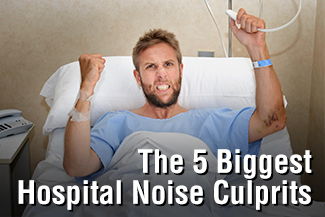What do the patient who watches their soaps at full volume, that old squeaky cart, and the visitor with the Justin Bieber ringtone that goes off constantly have in common? They create unnecessary hospital noise that can have negative consequences on patients, staff, and HCAHPS scores.
The good news? There are a number of easy, cost-effective steps you can take to help minimize hospital noise issues and reduce volume levels in your facility.
Here are the biggest hospital noise culprits along with recommended fixes:
Squeaky Carts: An essential in any hospital, carts are perfect for supporting caregivers during their rounds. But by the hundredth time you and your patients have to listen to the cart’s wheels squeak their way down the hall, this dream accessory seems more like your worst nightmare.
The Solution: Invest in carts with durable, silent casters that provide smooth, silent mobility.
Noisy Visitors and Patients: Visits from family and friends can cheer up patients and help with the healing process, but conversation levels can sometimes get a little loud and disruptive.
The Solution: Wall- or countertop-mounted noise monitors that change colors when noise has reached decibel threshold provide eye-catching indicators that remind those in the area to be aware of their volume levels.
Medical Equipment and the Loudspeaker Paging System: There’s no getting around some types of hospital noise. Audible alarms and alerts are essential for ensuring patients are getting proper care, but can make it difficult to rest and heal.
The Solution: Earplugs and patient comfort packs allow patients to block noise, while white-noise machines and fans can help minimize surrounding noises and provide a more peaceful atmosphere.
Caregiver Conversations: Not that you shouldn’t chat with coworkers in the hall or at the nurse’s station about that terrible blind date or latest episode of Game of Thrones, but not everyone in the vicinity needs to hear it.
The Solution: Noise management products that provide audio or visual indicators when noise levels reach a certain point are an easy way to let staff and patients know that they need to be aware of their volume.
The Television: Television can provide a fantastic distraction for healing patients, but while one patient absolutely has to see who got a rose on The Bachelor, the patient down the hall may not be interested in spoilers.
The Solution: Headphones allow patients to listen to the TV as loudly as they want without disturbing anyone around them. Earplugs are also an easy, cost-effective solution for blocking unwanted noises.
Check out MarketLab.com for more noise management solutions including text-enabled paging systems and No Interruption Flags.
